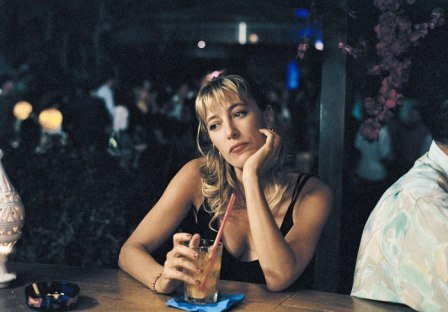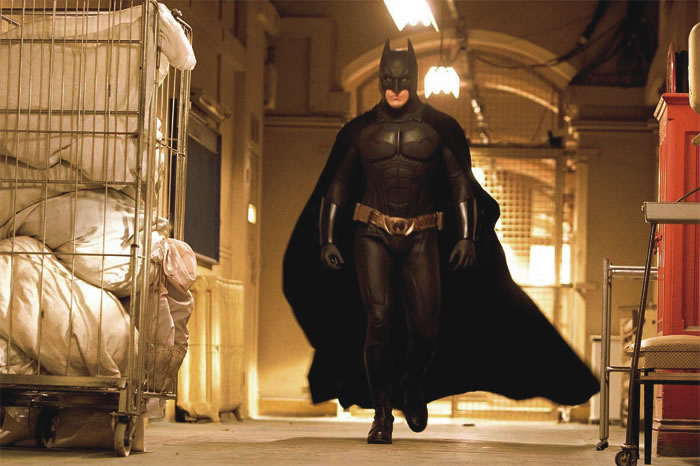As we approach 2005's midpoint, there has been no better picture to receive its American theatrical premiere this year than Apichatpong Weerasethakul's Tropical Malady, which opens today at New York's recently-christened IFC Center. The 34 year-old Thai auteur's third feature to garner significant international attention, Tropical Malady exceeds its predecessors in virtually every respect, showcasing a form that provides a potential new direction for art cinema worldwide. Apichatpong splits the narrative of Tropical Malady into two parts: the first is a gay romance focused upon a soldier and a small-town young man, while the second is a fable concerning another soldier's hunt for a shaman with the power of transforming himself into animal form.
If it sounds as if Tropical Malady is therefore comprised of two distinct short stories, the brilliance of Apichatpong's form rests in the interdependence of these discordant tales. On its own, part one (or part two for that matter) is a relatively pointless exercise in its subject matter: in the case of the first, the nascent romance of a same-sex couple concluding in an oblique gesture of physical love followed by the descent of one of the two into a dark forest. However, when taken with the second part, Apichatpong imbues his narrative with an entirely different meaning. Importantly, the folkloric second half self-consciously references filmic past through its recourse to intertitles, which in turn accentuate the section's antiquated fabulist narrative. This second part is juxtaposed with the modern narrative of part one, which depicts Thailand's hinter-regions as containing elements of the old and new in equal measure. Most examples of international art cinema, circa 2005, are no more than what Apichatpong depicts in this earlier section: man in a world which is in the process of modernizing, both in terms of its infrastructure, and more importantly, morally.
Yet, Tropical Malady defiantly undercuts the logic of part one, and in the process, modernist cinema: Hou Hsiao-hsien, this bitch-slap is directed at you. With part two, Apichatpong allegorizes the romantic coupling presented in the earlier half, arguing for the inherent compatibility of sex and death -- as such becoming the latest advocate of Bataille's conflation of the two. The all-smiles romance of the first part is revealed to be phony and transient, assuring a destruction symbolized by the stalking tiger. Indeed, it is worth remembering Apichatpong's opening quotation as a signifier of the meaning meted in part two: "all of us are by nature wild beasts... Our duty as human beings is to be like animal trainers... keeping our bestiality in check." This applies no less to the lovers than it does to the soldier and shaman -- and after all, it appears preceding the first part anyways. The pursuit of desire leads to the destruction signaled in the second half.
In fact, the meaning of the folkloric second half is to explain the oblique opening salvo, which in spite of its transparent form, offers a vision of society that is shown to be deceptive when refracted by its parallel half. (Consequently to call it "phony" is to do it a slight disservice: part one is the mirror image of part two, even if it is unintelligible without the second.) Similarly, a narrative concerning a hunter in search of a shaman that features intertitles, primitive illustrations, and a logic with no grounding in phenomenological reality becomes true in its revelations concerning human behavior. Again, part two is the interpretative matrix for the first. It also advocates a new kind of art cinema that dispenses with a default realism that is not only wanting, but fundamentally deceptive in its presentation of life's details: all cinema is selective in its narration; the stuff of fable is every bit as capable of clarifying life's crises, so long as the human condition remains immutable, as Apichatpong's adaptation of fable suggests.
If it sounds as if Tropical Malady is therefore comprised of two distinct short stories, the brilliance of Apichatpong's form rests in the interdependence of these discordant tales. On its own, part one (or part two for that matter) is a relatively pointless exercise in its subject matter: in the case of the first, the nascent romance of a same-sex couple concluding in an oblique gesture of physical love followed by the descent of one of the two into a dark forest. However, when taken with the second part, Apichatpong imbues his narrative with an entirely different meaning. Importantly, the folkloric second half self-consciously references filmic past through its recourse to intertitles, which in turn accentuate the section's antiquated fabulist narrative. This second part is juxtaposed with the modern narrative of part one, which depicts Thailand's hinter-regions as containing elements of the old and new in equal measure. Most examples of international art cinema, circa 2005, are no more than what Apichatpong depicts in this earlier section: man in a world which is in the process of modernizing, both in terms of its infrastructure, and more importantly, morally.
Yet, Tropical Malady defiantly undercuts the logic of part one, and in the process, modernist cinema: Hou Hsiao-hsien, this bitch-slap is directed at you. With part two, Apichatpong allegorizes the romantic coupling presented in the earlier half, arguing for the inherent compatibility of sex and death -- as such becoming the latest advocate of Bataille's conflation of the two. The all-smiles romance of the first part is revealed to be phony and transient, assuring a destruction symbolized by the stalking tiger. Indeed, it is worth remembering Apichatpong's opening quotation as a signifier of the meaning meted in part two: "all of us are by nature wild beasts... Our duty as human beings is to be like animal trainers... keeping our bestiality in check." This applies no less to the lovers than it does to the soldier and shaman -- and after all, it appears preceding the first part anyways. The pursuit of desire leads to the destruction signaled in the second half.
In fact, the meaning of the folkloric second half is to explain the oblique opening salvo, which in spite of its transparent form, offers a vision of society that is shown to be deceptive when refracted by its parallel half. (Consequently to call it "phony" is to do it a slight disservice: part one is the mirror image of part two, even if it is unintelligible without the second.) Similarly, a narrative concerning a hunter in search of a shaman that features intertitles, primitive illustrations, and a logic with no grounding in phenomenological reality becomes true in its revelations concerning human behavior. Again, part two is the interpretative matrix for the first. It also advocates a new kind of art cinema that dispenses with a default realism that is not only wanting, but fundamentally deceptive in its presentation of life's details: all cinema is selective in its narration; the stuff of fable is every bit as capable of clarifying life's crises, so long as the human condition remains immutable, as Apichatpong's adaptation of fable suggests.





